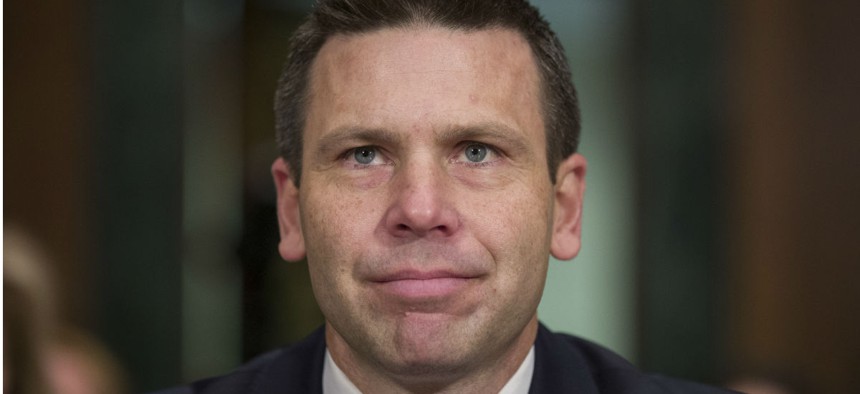
Customs and Border Protection Commissioner Kevin McAleenan called on Congress to change immigration laws. Alex Brandon / AP
DHS to Tap Multiple Offices to Provide Supplemental Staff for Border Patrol
Top official concedes the deployments will hamper mission-critical activities at employees' home agencies.
The Trump administration announced on Wednesday it will deploy federal employees outside of their normal jobs to provide support to law enforcement personnel along the U.S.-Mexico border, conceding the moves will have negative impacts on operations at those workers’ home agencies.
The deployments became necessary due to an influx of Central American family units crossing the southern border and seeking asylum, Customs and Border Protection Commissioner Kevin McAleenan said at a press conference in El Paso, Texas. While overall border apprehensions remain below the average rates seen over the last 10 years, McAleenan said the spike in family units coming through ports of entry has diverted the Border Patrol’s resources away from normal operations and toward services such as transportation and medical care.
Overcrowding at CBP facilities has grown so severe, he added, the agency is now releasing migrants into the United States with only a minimal screening. This marks the first time in 10 years CBP has taken such actions.
McAleenan called on Congress to change the nation’s immigration laws and override court decisions that he said force the administration to release migrants and encourage families to continue coming to the country. In the meantime, however, he announced 750 CBP officers will be diverted away from ports of entry to assist Border Patrol. They will serve in support roles, assisting with processing, transportation and hospital watch. The commissioner readily acknowledged the downsides of such a move.
“There will be impacts to traffic at the border,” McAleenan said. “There will be a slowdown in processing of trade. There will be wait times in our pedestrian and vehicle passenger lanes…but this is required to help us manage this operational crisis.”
He said the officers will come from ports throughout the southern border, but did not know how long they will serve in their temporary jobs. He called the transfer of resources an “immediate response to a crisis” without a definite end date.
McAleenan also announced CBP will activate individuals at the agency who previously volunteered to serve as part of a surge capacity force following natural disasters. The Federal Emergency Management Agency has activated employees through that authority, provided in the 2006 Post-Katrina Emergency Response Management Reform Act, after Hurricane Sandy and during the 2017 hurricane season. It was not immediately clear whether CBP will lean on that same authority, which applies specifically to FEMA, but McAleenan said it would pull from the cadre of employees who “volunteered to provide humanitarian assistance in a natural disaster.”
The commissioner said CBP will deploy employees from across the agency, such as human resources professionals and IT specialists, to “come down and help our Border Patrol agents manage this crisis.” CBP did not immediately answer inquiries about the deployments and the legal authority supporting them.
Craig Fugate, former FEMA director under President Obama, said it was unclear if the 2006 reform law applied to agencies outside of his former agency. He found it reasonable for CBP to tap into the database of employees willing to work temporarily in another capacity, while using the allowable reprogramming of funds to support their work.
"Why recreate a structure if there’s something already there?" Fugate said. He added the agency would only have to ensure it did not butt up against any direct prohibition from Congress, and likely receive permission from the Office of Management and Budget.
Fugate oversaw the Obama administration's response to the surge of unaccompanied minors at the southern border in 2014. He said as part of those efforts the administration moved some employees around to support front-line workers, but it was only a small number of workers in advisory or technical support roles.
"For short-term events like this, that would be a mechanism you could use," Fugate said. "Ideally you don’t want to pull people away for such a long period of time that it now detracts from the parent agency’s mission."
McAleenan also expects a multi-agency approach to addressing the situation at the border. He said the Defense Department will continue to offer more support and the Health and Human Services Department’s Public Health Service Commissioned Corps will provide medical assistance to migrants in need. CBP is already tapping a recently approved fiscal 2019 funding bump to augment contracts providing medical and food services. Recent border crossers have had issues with lice, influenza, fevers and seizures.
“We are doing everything we can to simply avoid a tragedy in a CBP facility,” McAleenan said, “but with these numbers, with the types of illnesses we’re seeing at the border, I fear it is just a matter of time.”
CBP has apprehended nearly 52,000 family units this month, more than 10 times the average in March in the previous five years. It has apprehended 268,000 total individuals so far in fiscal 2019, compared to 397,000 the previous year.
The employment surges come as Border Patrol has sought to drastically boost its own workforce, but has for years failed to do so. In 2018, the agency for the first time in several years added more employees than it lost, but that resulted in a net of just three agents at the Southwest border. In the early days of his administration, President Trump called on Border Patrol to hire a net of 5,000 new agents. CBP signed a contract with Accenture worth up to $300 million to help achieve that goal, but the agency was recently forced to dramatically scale that back after it failed to lead to any significant hiring.
NEXT STORY: New Manager Development: Put Your Back Into It







